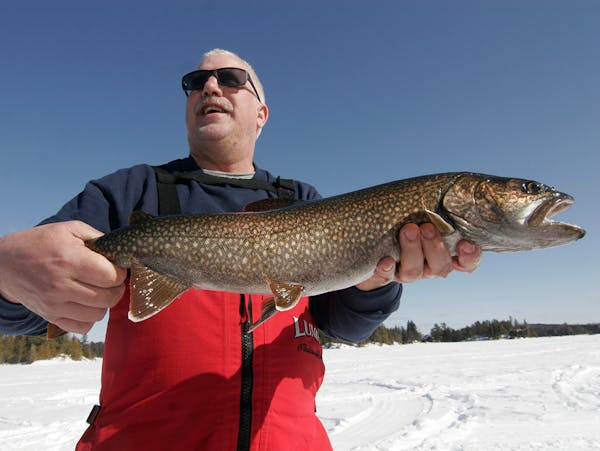NEAR STEWARTVILLE, MinN. – On the eighth anniversary of their marriage in Moscow, as in Russia, Wendell and Galina Diller went crow hunting and cooked pancakes over charcoal. This was Wednesday, south of Rochester, in a small woodlot, on the edge of a plowed cornfield.
Crow hunting is increasingly popular in Minnesota. Not for the bird's food value, though count me among those who have drowned their meat-challenged carcasses in wildly flavorful marinades before brazing them lightly on a grill only to find culinary disappointment.
The intent instead of taking up arms against these birds generally divides along two lines: They provide great sport — because they are difficult to fool with decoys and a call — and many people want their numbers reduced due to their nuisance value.
I have a foot in both camps, as do Wendell and Galina.
I have written about this couple before. Seeking a wife now nearly 10 years ago, Wendell was no stranger to website cruising. At the time, he was living with Don Helmeke, aka Don the Duckman, a good friend of both of ours, now deceased.
On the computer they shared, Wendell and Don had bookmarked more than a few pages boasting the qualities of Russian women. An engineer, inventor and ballistician (a form of gun nut), Wendell routinely bypassed the bombshell 20-year-olds and instead took a shining to Galina's profile, particularly the part about her advanced degree in chemistry.
"I like intelligent women," he said.
At the time, my two boys were about 9 and 11 years old, and the three of us regularly hunted with Wendell and Duckman, mostly for geese.
One morning, en route home from such an outing, Trevor, the older one, asked:
"What was Wendell talking about?"
"You mean Russian women?"
"Yes," the younger boy, Cole, chimed in. "What about Russian women?"
"They live a long way from here," I said. Then, "How 'bout breakfast at McDonald's?"
"Duckman talked about Russian women, too!" Trevor persisted.
"Yes he did," I said, "and there's no reason for your mother to know about any of it. Let's leave it at that."
But Wendell did not leave it at that. Convinced after corresponding with Galina by e-mail and Skype that she was not only intelligent but adventurous and, like him, an exercise buff, he decamped to Russia, where he disembarked from an Aeroflot flight and soon was mashing with Galina in Red Square.
Tracking the crow
To get close to crows with a gun, you have to be as smart as they are.
This is easier said than done, because smart isn't a term used loosely here. With oversized brains relative to other birds and proven ability to employ intelligence, rather than simply rely on instinct, crows can detect danger from afar, warn their brother and sister crows about threats and remember from year to year where problems arose during previous migrations.
Yet, too, they have weaknesses. For example, they are omnivorous with high-speed metabolisms and need to eat regularly.
For this reason, Wendell, Galina and I on Wednesday chose the small woodlot with mature trees alongside the cut cornfield in which to build our blind. The trees would hide us, while offering inquisitive passerby crows a possible perch site. Also we placed in the nearby corn a dozen crow decoys, including a "flapper," an electronically operated dummy bird whose wings moved hurriedly when commanded via wire and trigger.
For many years this type of setup has produced many successful crow forays for the three of us.
But change has come to Minnesota crow hunting. The birds have been chased so much in recent years by newcomers to the sport, particularly those using electronic calls, that they are far warier than they once were.
For this reason, Wendell uses only a mouth call. "Crows have warning calls, alert calls, rally calls, lots of calls," Wendell said. "The key for the hunter is to know which is which and not to overcall."
As Wendell spoke, the three of us crouched low, alert for the morning's first birds.
The 12-gauge shotguns we brandished were outfitted with 7-foot-long, heavily ported barrels and were invented by Wendell to reduce the sound of the guns to minor poofs. The intent, as always when we deployed these firearms, was to pull one or two crows (or in other instances one or two ducks or geese) from small flocks without disturbing other birds.
Wendell also brought along a box of Winchester TrAAckers. These were 8-shot target loads, with special wads that act as tracers so wing shooters can see whether they are on target, ahead or behind.
This is novel stuff, and Winchester only began marketing the cartridges last year.
"I wanted to use them this morning to help Galina learn where she is shooting, not on clay targets, but on actual crows," Wendell said.
We had a good morning's hunt, during which we downed a few birds while learning a little more about crows and a lot more about using tracers to teach marksmanship in the field.
Then we celebrated Wendell and Galina's anniversary by eating pancakes cooked over charcoal in a small grill we toted into the field.
A great sport, Galina was asked by Wendell how she wanted to spend the rest of the day.
Wendell knew napping wouldn't be part of the agenda, despite their 4 a.m. departure from the Twin Cities.
"I want to go running," Galina said. "Then to the athletic club to work out, and to swim."
Dennis Anderson • danderson@startribune.com

Anderson: Celebrate Earth Day by rekindling real connection to nature
Anderson: Anglers protesting tough new Mille Lacs rules are wrong

Anderson: Courts, not politicians, should rule on Red Lake, White Earth lands

Anderson: Multimillion windfall gets invasive carp deterrent moving
![A young whitetail deer searches for food as another blanket of snow coats the arrowhead. ] Minnesota -State of Wonders, Arrowhead in Winter BRIAN PETE](https://arc.stimg.co/startribunemedia/WK32UWWY6FKNWJUIYCJ6ZPT4AU.jpg?h=91&w=145&fit=crop&bg=999&crop=faces)

